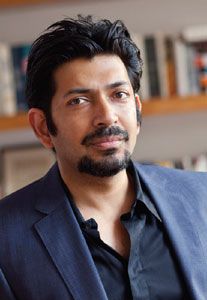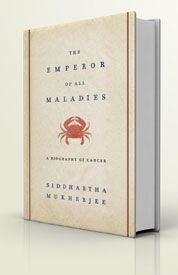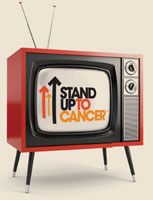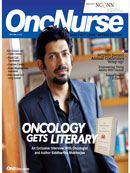Interview With Siddhartha Mukherjee, Author of The Emperor of All Maladies
Siddhartha Mukherjee, MD, discusses his book The Emperor of All Maladies.

The Emperor of All Maladies
New York Times
Siddhartha Mukherjee, MD, is having a good year. His book was recently named one of the 10 best books of the year by the , whose reviewer called it “one of the most extraordinary stories in medicine.” In addition to his new career as an author, Mukherjee is a practicing oncologist, a cancer researcher, and an assistant professor at Columbia University in New York. He is also a husband and father. I had the honor of interviewing Dr Mukherjee in September 2010.
OncLive Nursing: I’m sure you’ve been asked this many times—what inspired you to write this book?
Mukherjee
: The book is a very long answer to a question first posed to me by a patient that I was treating in Boston, a woman with a very aggressive form of abdominal cancer. She had been treated with chemotherapy and relapsed and treated again. At one point, she said, “Well, I’m willing to go on, but in order to go on I need to know what it is I’m battling.” She, unfortunately, passed away, but the book is an attempt to give a full answer to that question. What is it that patients face? What is it that we face culturally today and what is it that we face emotionally, intellectually, and scientifically when we try to battle cancer?
The book tries to answer the question by going back to the very origin of the disease and showing its development through history. That is why it is called “a biography of cancer,” because it really treats cancer as if it were an entity, a personality, almost kind of an alter ego…The book was written because of that, to flesh out this incredible mysterious magisterial disease that has really taken over our lives in society.
Did you have a particular audience in mind while writing it? Was the idea mainly to write it for patients or for a layperson to understand?
The book is written entirely for a layperson to understand, but I wanted to treat this audience with the utmost seriousness. If you look at Amazon, you find 5000 books about cancer…but I felt as if there was a vacuum and that none of these books addressed the kinds of questions that patients and families have, which is a desire to have a larger history, one that goes back to the origins and then takes us into the future.
The book was written keeping in mind not only patients, not only families, but also the most general reader who wants to know how this disease came about and what its future might be. It was written with the scientist in mind. It was written with the student in mind. It was written with the reader of literature in mind…Cancer has played such a large role in every aspect of our society.
"Every era casts cancer in its own image, and this happens to be the era of genetics."
The book drives home the amount of suffering patients experienced in the past that allowed us to get where we are today. What made you decide to focus so much on this aspect of cancer’s story?
That’s absolutely true; one of the very many messages of the book is that there are other people who have actually given up their lives to help us understand more about this disease. I think we need to remember them and do their memory honor. Practically speaking, that means participating in the fullest level in understanding cancer. That might mean understanding it culturally; that might mean understanding it socially; that might mean participating in clinical trials. It might mean spearheading prevention mechanisms. I think one of the points of the book is to say, “Let’s make sure that these people didn’t do this in vain.”
You wrote about journalist Stewart Alsop, treated for cancer at a ward at the National Institutes of Health in 1973, who said of his experience that “Saving the individual patient is not the essential mission…the basic [goal] is not to save that patient’s particular life but to find means of saving the lives of others.” Have things changed since then?
I think it has changed somewhat. One of the things that is very frustrating about any disease, but particularly frustrating about cancer, is the iterative quality of knowledge. It’s like building a very large building brick by brick by brick, and every single brick only seems to add a tiny increment…For people watching from the outside, it seems as if the process is interminably slow, but I think it’s very important to understand that if no one iterates then you never go forward. The increments are absolutely important to build the larger edifice against cancer. I think there’s always a tension—and perhaps a healthy tension—between making the iteration that really speaks to the future and to treating a patient in the here and in the now. And this practice is ancient; this has happened since the history of medicine, and I think that’s very much part of the book.
"To take care of cancer patients is an enormous privilege, but it also involves deploying everything that is in your toolbox: the emotional, the psychological, the scientific, the epidemiologic, and palliative medicine."
A recent retrospective in the New York Times suggested that, because death rates had not declined monumentally since 1971, not much progress had been made against cancer. Would you say The Emperor of All Maladies attests to a lack of progress in oncology?
Absolutely not, no. I wanted to counter the nihilism around cancer. There is a very clear place that lies between the nihilism that has recently been all over the newspapers and the over-optimism—or the hype— that existed 5 to 10 years ago and certainly 30 years ago. To lean in one direction while neglecting the other…does a disservice to the actual progress that has been made. There’s kind of a pendulum quality about [cancer research], kind of a nauseating roller coaster quality. One decade we’re told that we are making such enormous progress on cancer, so that the whole thing is going to be licked or cured in 5 months, and the next decade, as if on the other side of the roller coaster, we’re told that the whole project is bust and that nothing has happened. And clearly, neither of those things are true. In certain cases, there have been vast inroads made, and to be nihilistic about those inroads is really to deny history.

The Emperor of All Maladies
tells me—to paraphrase an old cliché—that the more progress we make, the more we discover how much progress we have left to make. That’s right, yes, absolutely. The sequencing of the cancer genome is a good example. Any presumption that people might have had about the simplicity of cancer…[was] completely broken apart. It revealed deep complexities within cancer. To give you an example: If you sequence the genomes of multiple specimens of breast cancer, you fi nd deep disparities between even truly identical-looking specimens. So, you might take a nihilistic approach to this and say, “Gosh, this is an unsolvable problem.” Yet, if you look deeply, you fi nd that within those wide differences you can begin to see organizational patterns. In the book, I call it a kind of music behind the genes. Again, you have to go through additional cycles of knowledge and thinking before you can make the next discovery.
Do you think we need to change the way we educate patients and the public about cancer to move away from the mind-set that cancer is a single disease, to explain that it comprises many diseases?
Absolutely. Part of my attempt with this book is to allow the public to understand the level of complexity and thereby appreciate the ingenuity and the resilience of knowledge that has come about in terms of discovery.
You described an almost unilateral focus early in the 20th century by some prominent cancer researchers and virologists on viruses as the only cause of cancer, which was later disproved. Some of today’s most prominent researchers—such as Robert Weinberg, whose fundamental discoveries on cancer genetics you discuss in the book—are now saying too much focus is placed on genetic mutation as the cause of cancer and too little research is being devoted to seeking other possible causes. Do you agree with Weinberg or do you feel keeping the focus on genetics offers the best opportunities for improving care?
I think that genetics is only a small part of it. I think it’s a vital part, but I think it’s only one piece of a much larger puzzle. There’s a line in the book about how every era casts illness in its own image. Well, every era casts cancer in its own image, and this happens to be the era of genetics. Therefore, we use genetics to understand cancer. There was a time when viruses were all the rage, and we had to use the lens of viruses to understand cancer.
These pieces of the puzzle are expanded until they reach their logical natural limit, and then we move on to the next piece of the puzzle; we discover that this one piece will not fit the entire thing, will not fit the entire puzzle. So I think Weinberg’s right—cancer genetics is surely an important piece of this puzzle, but I think the next series of breakthroughs will involve something beyond cancer genetics. Just to name a few things, the role of the microenvironments in cancer is very, very under-appreciated—it’s an expanding field. The understanding of epigenetics in cancer? Also an interesting, exploding fi eld. The relationship between the biology of cancer and the stem cell? Also a deeply complex field that involves genetics and involves the microenvironment.
In The Emperor of All Maladies, you talk about how some physicians become indifferent not just to death but also to life. What do you mean?
Well, I think anyone who has spent time in the oncology clinic understands that it can be—if you look at it in a certain way—a very depressing place. You can get very easily depressed and nihilistic, as I said before, about what is happening in cancer. Perhaps the most striking sign of that is when young residents and fellows come and say, “You know, I don’t want to become an oncologist because everyone dies.” It is absolutely not true.
To take care of cancer patients is an enormous privilege, but it also involves deploying everything that is in your toolbox: the emotional, the psychological, the scientifi c, the epidemiologic, and palliative medicine. Every aspect of medicine is involved, and the difference that you can make to a person’s life as an oncologist is incredible. You’re present, to a large extent, among the most moving and terrifying times of a person’s life, and the ability to help at that time is like a transcendental experience.
When you have to deliver bad news, how do you prepare for that?
I think what really helps is to listen to the person you’re delivering bad news to. That’s the first thing that I’ve learned from my teachers. And by that, I mean that often bad news [involves] a crushing or a deflation of aspirations. Someone wants to attend their daughter’s graduation, and that may be 2 months away; another person’s goals might involve graduating from college herself or watching a granddaughter or grandson’s birthday.
bad news means
If you understand [the patient’s] goals and how they may or may not be achieved—what is achievable and what is not achievable—I think it makes the conversation very concrete. That concrete conversation can be very hopeful, because you can say, “Well, the limits of the bad news are that, based on what’s happening, I doubt that this is a process that will carry on for 5 or 10 years. But…if it means a lot for you to watch your son reach this landmark moment in his life, we can probably get there and we can be there together.” I think it really mitigates what .
It is clear that every day of life is very important to the patients whose stories you share in your book. How do we balance the patient’s desire to live as long as possible against arguments from those who say 2 months of life is not a justifi able trade-off for an expensive medication?
I think, once again, it depends on clarifying what the goals are…For every person, the desire to live the most healthy, long life is an incredible gift, and who would not want that? Every day matters. But coming to terms with death, which the book addresses in great detail, is an important component of that. So, for the person who says, “I want to live 1 more day on a medicine that costs tens or hundreds of thousands of dollars,” we need to ask them what they’re trying to get to, what the real anxiety is there, and to try to help them find the answers.
"Somehow, the American public still thinks medicine is performing experiments on it, but really, medicine should be performing experiments with patients."
The Emperor of All Maladies
appears to highlight how ego and distrust between professionals in the different disciplines, such as surgery and chemotherapy, hindered progress in cancer research. Has this gotten better?
I think it’s gotten vastly better because the prior years have been humbling, and the silos of disciplines have become less siloed. These days, there is hardly a cancer center in which there are not collaborative groups between surgeons, chemotherapists, and radiation oncologists. I think that model evolved out of those humbling experiences—the idea that you can’t just use one weapon to battle cancer but must instead deploy multiple ones. A cancer patient today really has a team that works around him or her, including nurses, psychiatrists, psychologists, and, in some cases, pain and palliative medicine experts. Those silos have really been broken, to an extent.
Do you think community oncologists are reluctant to adopt new discoveries in practice?
No, I don’t think so. I think community oncologists are really the frontline of cancer medicine. I have enormous respect for community oncologists because much more than oncologists at tertiary care centers, they see the full range and breadth of the disease. When I was [working] in Boston, the one person’s judgment who I trusted almost universally was the very fi rst oncologist that the patient often saw, and this often was a community oncologist. They had a real sense of what was happening not only medically to the person, but also socially, emotionally, and so forth, and made a very valuable ally in treating a patient.
Reflecting on some of the individuals you discuss in the book who made major advances in cancer care, like William Stewart Halsted and Sidney Farber, it becomes difficult not to take an almost critical view of some of their actions.
By critical, you mean because of the nature of the aggressiveness?
Yes, or in some cases, their lack of receptiveness to other possibilities. How do you reconcile the important contributions Farber made, for example, with what seems like a reckless disregard at times for his patients?
Thankfully, there are boards now and institutional review boards that prevent people from doing reckless things. But I think there is a sense, quite universally, among medical oncologists—and I’ll probably upset a lot of people when I say this—a sense that some of that…adventurousness has been dampened in the clinical realm. There was a time in the 1950s when the pendulum was clearly at the other end of that spectrum, when really dangerous experiments were launched on human beings. But I believe I speak for at least some of my colleagues in thinking that we’ve perhaps swung a little too far in the opposite direction and the capacity to bring drugs to the clinic today has met with a kind of…dullness, which I think is a problem.
Do you think the historical memory of those early experiences with basically unregulated clinical trials is at all responsible for the very negative regard many Americans today have of clinical trials and their reluctance to participate?
No, I don’t think that’s the reason. I think there’s a lot of reluctance about clinical trials because we’ve done a very bad job of educating the public on what a clinical trial means and how important it is and how the only way to learn with this disease is to participate. In other words, if we don’t partner with patients, then this discipline is lost. The partnership with patients is absolutely critical.
on
with
on
with
In the book, I talk about the famous Herceptin trials. Genentech and breast cancer activists really didn’t see eye-to-eye until they figured out that the only way to move forward was to combine their efforts, such that Genentech—as I say in the book—decides not to perform experiments breast cancer patients but instead performs experiments breast cancer patients. That’s the critical piece that is missing. Somehow, the American public still thinks medicine is performing experiments it, but really, medicine should be performing experiments patients.
You spend several pages discussing early advocacy efforts and how people like Mary and Albert Lasker and Farber convinced the public to pay attention to this disease and mobilized funding. Sometimes, things became political, and we see this today, with Avastin, for example. The science seems to suggest it might not be as effective in breast cancer as previously thought, yet some groups and politicians are pressuring the FDA not to rescind approval. We see the same thing with prostate and breast cancer screening, with researchers largely on one side and advocates pushing for something else. How do you reconcile the two?
Well, first of all, you balance the issue through the tried and tested mechanisms of politics, which is to try to reach compromises between the desire to push forward with an experimental approach and the desire to stick with what’s known. That involves, again, a degree of education and a degree of diplomacy between patient advocates and, for instance, the FDA or hospitals.

Is Mukherjee’s Magnum Opus Coming to the Small Screen?
Stand Up To Cancer (SU2C), the entertainment industry’s high profile cancer advocacy organization, has acquired the TV and fi lm rights to The Emperor of All Maladies. SU2C is considering several adaption options across multiple media, including TV, Internet, and DVD. Profi ts generated will support the ongoing translational research of SU2C’s multidisciplinary Dream Teams. “I deeply admire the incredible and path-breaking work that SU2C has done in cancer advocacy and cancer research, and cannot think of a better partner. This story needs to reach the public and SU2C is poised to make that happen,” Mukherjee said in a press release.
The second way you approach this is by creating more data. A lot of this has to be driven by what is known and what is not known. If there’s a question, then it should be answered in such a setting that allows you truly to answer the question as opposed to pushing forward because of anecdotal evidence for this, that, and the other.
To give you an example, there has been a lot of controversy about whether mammography should be performed between the ages of 40 to 50, and there’s been a lot of back and forth about this. It’s very controversial. The way to resolve this is either to perform an extremely detailed analysis of patients between 40 to 50 [years of age] who have been screened with mammography and fi gure out whether this is a preventive mechanism that allows us to save lives; or to say, “This is not going to work because the technology does not have the resolution required to catch a small breast tumor in a woman between 40 and 50 [years of age].” Let’s then find a mechanism to screen better, to risk stratify better, so that high-risk women, for instance, can be given mammographic exams, and determine whether that saves lives…The answer almost always lies in thinking deeply about what the data show and making modifi cations in response until a compromise is reached between advocates and regulatory bodies…They all want the same thing, which is to try to get patients to live longer in the best possible manner for the longest possible time.
As a practicing oncologist and a father, where did you find time to write a book so big and so complex?
I had to make time, and I think what was important was to have a reason to do it. And the reason to do it, as I mentioned, was that I was trying to answer my patient’s question. As long as I always kept that in mind, I felt as if the book sort of wrote itself.
I would come back usually every evening after rounds or from the laboratory and I would promise to write. But I didn’t write 5 or 10 pages at a time…I kept writing until I had answered the question that had been left over from the night before. For instance, when I was writing about…mammography, the previous night’s question might have been, “Where did this leave us in 1986?” And then the next day’s writing would bring us from that period up to 1996, filling out the story in between. I think I was able to write because, again, I was responding to a certain sense of urgency that this story had to be told.
As you were writing, did you learn a lot you had not known about cancer research?
I learned enormously. I learned my own history. I really hope people enjoy the book, and I hope that others learn from it. It’s a very humbling story, but it’s also a story about the future. It’s gotten very good early coverage…which has been very gratifying.

Latest Conference Coverage

As Orthopedic Oncology Evolves, Caring for the Clinician Must Be a Priority

Belumosudil Produces Long-Term Responses Without New Safety Concerns in cGVHD

Prophylactic Itacitinib May Safely Mitigate CRS Following Axi-Cel Administration in Lymphoma

Serial ctDNA Testing Could Improve Risk Stratification in High-Risk MIBC
2 Commerce Drive
Cranbury, NJ 08512